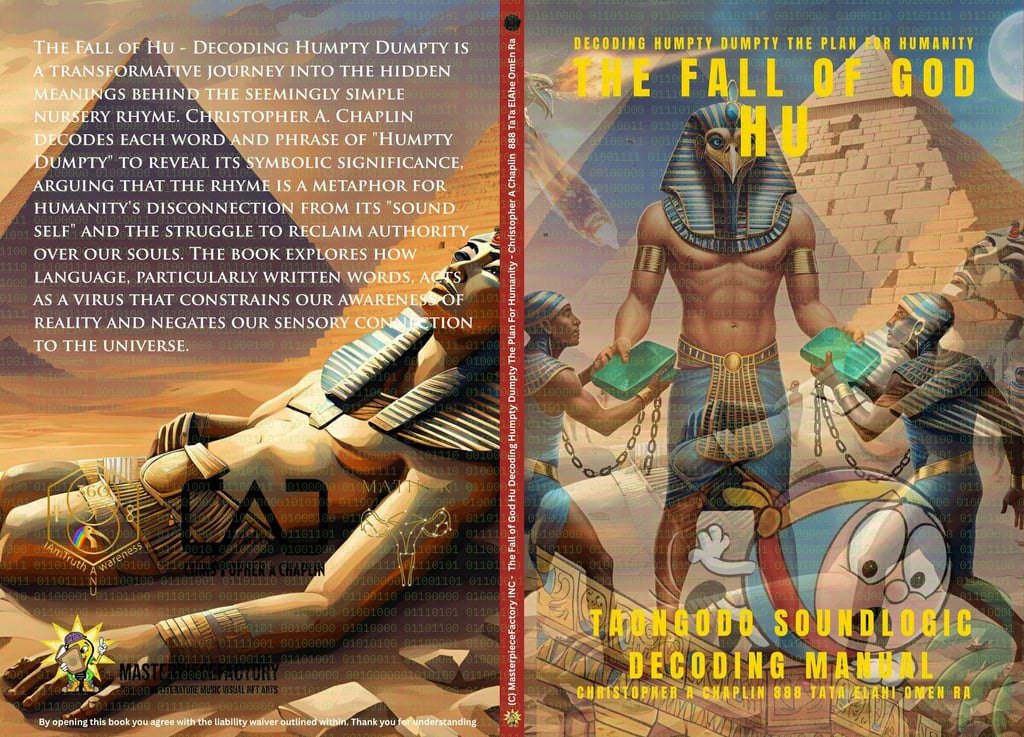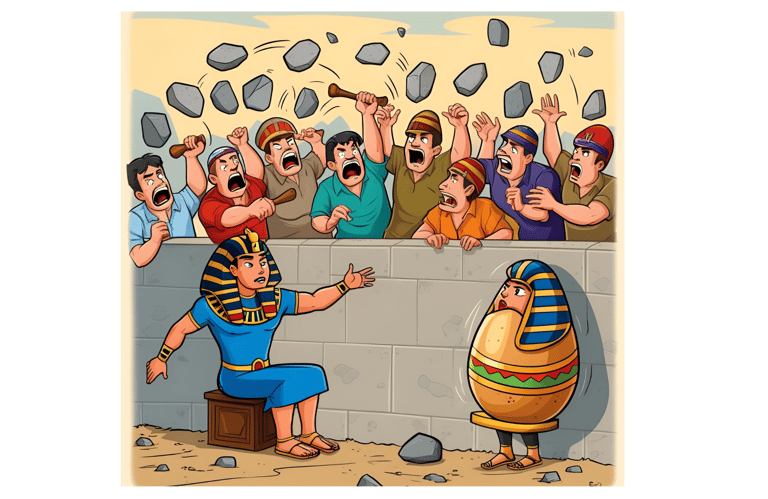Tier4 OmenStanding Deprogram Keys
SOUND WARFARE FOR THE AWAKENED
TaTa OmEn Ra Decoding THE FALL OF HU—AND YOUR SOUL’S JAILBREAK STARTS HERE.
HUMPTY DUMPTY WAS PUSHED.
The nursery rhyme was a cover-up. A sonic crime scene. Christopher A. Chaplin’s *The Fall of Hu* exposes the truth:
His "great fall" was linguistic assassination—the day SOUND was chained to SYMBOLS.
HUMANITY IS THE EGG. THIS BOOK IS THE HAMMER.
AT YOU’LL UNLOCK:
HEADITCHY POETRY – Melt mental prisons with vibration, not vocabulary.
SOUNDLOGIC – Reason with THROAT, not theory. (Words are virus. Sound is truth.)
OMENOLGO – Sound spawns matter. Your voice is a SOURCE FORCE.
TAONGODO – A language of FREQUENCY, not fraud. Silence the spells.
THE VERDICT:
"After this book, you’ll HEAR the Patrix NOT MATRIX—then SMASH it with your larynx."
STOP READING. START VIBRATING.
THE SOUND WAR STARTS NOW.
- "Language is a virus."
- "Your name is a spell."
- "Sound is the only real math."
- "Humpty Dumpty was PUSHED BY THE KING SO YOU CAN MOURN AND SING."
Introduction
The Fall of Hu - Decoding Humpty Dumpty The Plan for Humanity by Christopher A. Chaplin is a ground-breaking exploration of language, sound, and consciousness that challenges readers to rethink the foundations of human thought and communication. Through a meticulous decoding of the classic nursery rhyme "Humpty Dumpty," Chaplin unveils a profound philosophical framework that connects sound, language, and the human experience. This book is not merely an analysis of words; it is a call to reclaim our "sound selves" and reconnect with the vibrational essence of existence. By introducing innovative concepts like HeadItchy, SoundLogic, OmEnOlGo, and TaOnGoDo, Chaplin provides readers with tools to dismantle cognitive dissonance and erect a higher-self architecture. This work is a must-read for those seeking to understand the deeper layers of language, spirituality, and the human condition.




WARNING: YOUR LANGUAGE IS A LIE. YOUR NAME IS A SPELL. YOUR MIND IS A BATTLEGROUND.
Synopsis
The Fall of Hu – Decoding Humpty Dumpty is a transformative journey into the hidden meanings behind the seemingly simple nursery rhyme. Christopher A. Chaplin decodes each word and phrase of “Humpty Dumpty” to reveal its symbolic significance, arguing that the rhyme is a metaphor for humanity’s disconnection from its “sound self” and the struggle to reclaim authority over our souls. The book explores how language, particularly written words, acts as a virus that constrains our awareness of reality and negates our sensory connection to the universe.
Chaplin introduces readers to his original concepts:
HeadItchy: A genre of poetry and prose that encourages self-reflection and intellectual exploration.
SoundLogic: The practice of using sound as the foundation for reasoning and communication, emphasizing that no two sounds create the same vibration.
OmEnOlGo: The study of how sound vibrations originate matter, focusing on re-establishing a sound mind by reconnecting with our senses.
TaOnGoDo: A sound-based language that filters out the “spells” embedded in words, aligning our thoughts, speech, and actions with the frequencies of the universe.
Through these frameworks, Chaplin argues that humanity’s reliance on symbolic language (words, numbers, and signs) has led to cognitive chaos and a detachment from our true essence. The fall of Humpty Dumpty symbolizes this disconnection, while the inability to “put him together again” represents the challenges of reclaiming our sound selves in a world dominated by artificial constructs.
The book also delves into the philosophical and spiritual implications of sound, asserting that sound is the origin of matter (OM) and that reconnecting with our sensory and vibrational roots is essential for mental health and spiritual evolution. Chaplin critiques modern society’s reliance on technology and artificial intelligence, warning that these tools further detach us from our sensory and etheric connections.Ultimately, The Fall of Hu – Decoding Humpty Dumpty is a call to action: to return to sound as the foundation of thought, communication, and existence.
It challenges readers to decode the language they use, reclaim their authority over their souls, and align themselves with the vibrational frequencies of the universe.
Christopher A. Chaplin’s The Fall of Hu – Decoding Humpty Dumpty is a multidisciplinary work that blends linguistics, philosophy, spirituality, and metaphysics. The book’s strength lies in its innovative approach to language and sound, offering readers a new lens through which to view their existence. Below is a breakdown of the key analytical points:
Language as a Virus:
Chaplin argues that written language is a parasitic program that constrains human thought and disconnects us from our sensory and vibrational roots. Words, he claims, are “spells” that embed cognitive dissonance and confusion into our minds.
By decoding words like “God,” “Authority,” and “Human,” Chaplin reveals how language perpetuates a false construct that opposes the natural frequencies of the universe.
Sound as the Origin of Matter:
The book emphasizes that sound (OM) is the primordial force that creates matter. Chaplin introduces TaOnGoDo, a sound-based language that aligns thought, speech, and action with the vibrations of the universe.
This concept challenges readers to move beyond symbolic communication (words and numbers) and return to a sound-based mode of thinking and being.
The Fall of Humpty Dumpty as a Metaphor:
The nursery rhyme is reinterpreted as a metaphor for humanity’s fall from its “sound self.” Humpty Dumpty’s great fall represents the disconnection from our vibrational essence, while the inability to “put him together again” symbolizes the challenges of reclaiming our true nature.
Chaplin uses this metaphor to critique modern society’s reliance on artificial constructs, such as technology and religion, which further detach us from our sensory and etheric connections.
Philosophical and Spiritual Implications:
The book explores the philosophical implications of sound and language, arguing that mental health is intrinsically linked to our connection with the universe’s vibrational frequencies.
Chaplin critiques the Draconian systems of religion and authority, which he claims disconnect us from our source and co-opt our spiritual essence.
Practical Tools for Self-Transformation:
Through concepts like SoundLogic and TaOnGoDo, Chaplin provides readers with practical tools to decode language, dismantle cognitive dissonance, and reconnect with their “sound selves.”
These frameworks encourage readers to think critically about the language they use and to align their thoughts, speech, and actions with the vibrational frequencies of the universe.


Incubating Symbology doesn't hatch soundLogic
Testimonials
Deshanae Harris:
Christopher breaks down the decoding to make it understandable even for a child. A good, easy read, yet very informative.


Incubating Symbology doesn't hatch soundLogic

Contact Us
Reach out for inquiries about our responsive course offerings.
Unlock your spiritual journey with our courses.
TaTa@erectionary.com
© SO 25 R 5 / 2025. MasterpieceFactory Inc All rights reserved.
